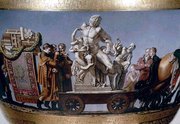|
|
The statue of Laoco÷n and his Sons, also called the Laoco÷n Group, is a monumental marble sculpture, now in the Vatican Museums, Rome. The statue is attributed by the Roman author Pliny the Elder to three sculptors from the island of Rhodes, Agesander, Athenedoros and Polydorus. It shows Laoco÷n and his sons Antiphantes and Thymbraeus being strangled by sea serpents. Both the Iliad and the Aeneid describe this as Poseidon's wrath for Laoco÷n's attempt to expose the ruse of the Trojan Horse. (See the Aeneid quote at the entry Laocoon.)
Various dates have been suggested for the statue, ranging from about 160 BC to about 20 BC. Inscriptions found at Lindos in Rhodes date Agesander and Athenedoros to a period after 42 BC, making the years 42 BC to 20 BC the most likely date for the Laoco÷n statue's creation.
The statue, which was probably originally commissioned for the home of a wealthy Roman, was unearthed in 1506 near the site of the Golden House of the Emperor Nero (who reigned from 54 to 68 AD), and it is possible that the statue belonged to Nero himself. It was acquired by Pope Julius II, an enthusiastic classicist, soon after its discovery and was placed in the Belvedere Garden at the Vatican, now part of the Vatican Museum.
The discovery of the Laoco÷n statue made a great impression on Italian sculptors and significantly influenced the course of the Italian Renaissance. The sculptor Michelangelo is known to have been particularly impressed by the massive scale of the work and its sensuous Hellenistic aesthetic of the statue, particularly its depiction of the male figures.
The influence of the Laoco÷n statue is evidenced in Michelangelo's Battle of Cascina: cartoons for this work show that he used several variants of the poses in the Laoco÷n group. Many of Michelangelo's later works, such as the Rebellious Slave and the Dying Slave, were also influenced by the Laoco÷n. The tragic nobility of this statue is one of the themes in Gotthold Lessing's essay on literature and esthetics, Laoko÷n, one of the early classics of art criticism.
Ac.laocoon2.jpg
When the statue was discovered, Laoco÷n's right arm was missing. Artists and connoisseurs debated how the missing parts should be interpreted. Michelangelo suggested that the right arm was originally bent back over Laoco÷n's shoulder. Others, however, believed it was more appropriate to show the right arm extended outwards in a heroic gesture. The Pope held an informal contest among sculptors to make a replacement right arm, which was judged by Raphael. The winner, in an outstretched position, was attached to the statue.
In 1957, however, the original right arm was found in a builder's yard in Rome, and was in the position which had been suggested by Michelangelo. The arm has now been rejoined to the statue. There are many copies of the statue, including a well-known one in the Grand Palace of the Knights of St. John in Rhodes (illustration, left), which still show the arm in the outstretched position.
The Florentine sculptor Baccio Bandinelli was commissioned to make a copy by Pope Leo X de' Medici. Bandinelli's version, which was often copied and distributed in small bronzes, is at the Gallery of the Uffizi, Florence.
The original was seized and taken to Paris by Napoléon Bonaparte after his conquest of Italy in 1799, and installed in a place of honour in the Musée Napoléon at the Louvre, where it was one of the inspirations of neoclassicism in French art. Following the fall of Napoléon, it was returned by the British to the Vatican in 1816.


